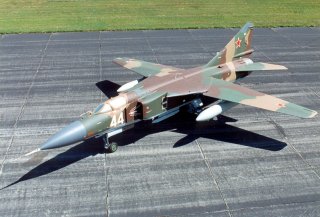Why Russia Isn’t Sad to See the MiG-23 Fighter Go Away
Conceived in the late 1960s as the Soviet answer to the likes of the legendary F-4 Phantom II jet fighter, the MiG-23 fighter jet (NATO reporting name Flogger) seemed poised for battlefield success.
Here's What You Need to Remember: So impressively thorough and consistent is the MiG-23’s record of failure that it bears the dubious distinction of facing retirement earlier than the MiG-21 jet fighter it was meant to replace. The Soviet Air Force quickly moved on to the much more successful MiG-27.
Developing and mass-producing a piece of hardware as complex as a jet fighter is a notoriously difficult and winding endeavor. From flawed concepts to poor execution, the potential for failure lurks behind every corner. Even for successful projects, things seldom go exactly as planned; the designer is faced with a constant stream of difficult engineering choices, further muddled by bureaucracy, politics, and budgetary factors.
Picking the worst fighter of all time is no easy task—one quickly finds themselves spoiled for choice. But there is one way to give this exercise some semblance of structure by way of three criteria. The fighter has to 1) be mass-produced, 2) serve in at least one air force for no less than five years, and 3) have a sufficient combat record for us to be able to meaningfully evaluate its performance in a non-controlled environment. These three basic requirements allow us to filter out prototypes/experimental fighters like the Grumman X-29 and Su-47, which deserve a list of their own, as well as poorly designed fighters that were never tested on the battlefield. With these caveats out of the way, here is the worst fighter of all time.
Conceived in the late 1960s as the Soviet answer to the likes of the legendary F-4 Phantom II jet fighter, the MiG-23 fighter jet (NATO reporting name Flogger) seemed poised for battlefield success. The Flogger was built around a simple, yet compelling design philosophy: a light, single-engine variable-geometry wing jet fighter that retained the agility of its MiG-21 predecessor, but added modern avionics, improved handling, greater range, an expanded armament suite, and more robust targeting capabilities.
This was all supposed to add up to a powerful, versatile fighter capable of performing both attack and interception roles. However, the results left much to be desired. Contrary to the Soviet goal of building a capable dogfighter, later tests discovered that the MiG-23 jet fighter was handily out-turned by western counterparts like the F-15 Eagle. Moreover, the fighter was prone to instability issues at a high angle of attack; test pilots complained of Yaw instability at higher speeds and landing difficulties in poor weather conditions. The MiG-23 was not only notoriously difficult to operate, but suffered from numerous technical failures. Its R-29 engine, for instance, had a short lifespan and tended to overheat, while the fuel tank system was held back by design flaws that were fixed only on later MiG-23 models. Not only was the MiG-23 a step backward from the MiG-21 in some respects, but its operating costs were higher than its predecessor.
Still, how did it perform? There is no ambiguity here: the MiG-23 boasts a long, well-documented, and deeply embarrassing service record. The full extent of its failures is too great to recount in detail, but here are a few highlights. Over a dozen Syrian MiG-23 jet fighters were shot down by Israeli F-15s and F-16s over the course of the Arab-Israeli Wars. Iraqi MiG-23 jet fighters also fared even more poorly against Iran during the Iran-Iraq War, reportedly suffering upwards of fifty losses against Iranian F-14s, F-5s, and F-4s. Libyan MiG-23s were routinely outperformed by Egyptian MiG-21 jet fighters during the Libyan-Egyptian War, and two of these fighters were destroyed by two U.S. F-14 Tomcats during the 1989 Tobruk skirmish.
So impressively thorough and consistent is the MiG-23’s record of failure that it bears the dubious distinction of facing retirement earlier than the MiG-21 jet fighter it was meant to replace. The Soviet Air Force quickly moved on to the much more successful MiG-27. Most of the Flogger’s Warsaw Bloc customers likewise found better alternatives in prior decades. Syria and North Korea are the largest operators of the world’s remaining MiG-23s. The Flogger exists in military aviation history as a grim reminder that even the soundest design concepts can be tarnished by subpar execution.
Mark Episkopos is the national security reporter for the National Interest. This article first appeared earlier this year.
Image: Wikipedia.

